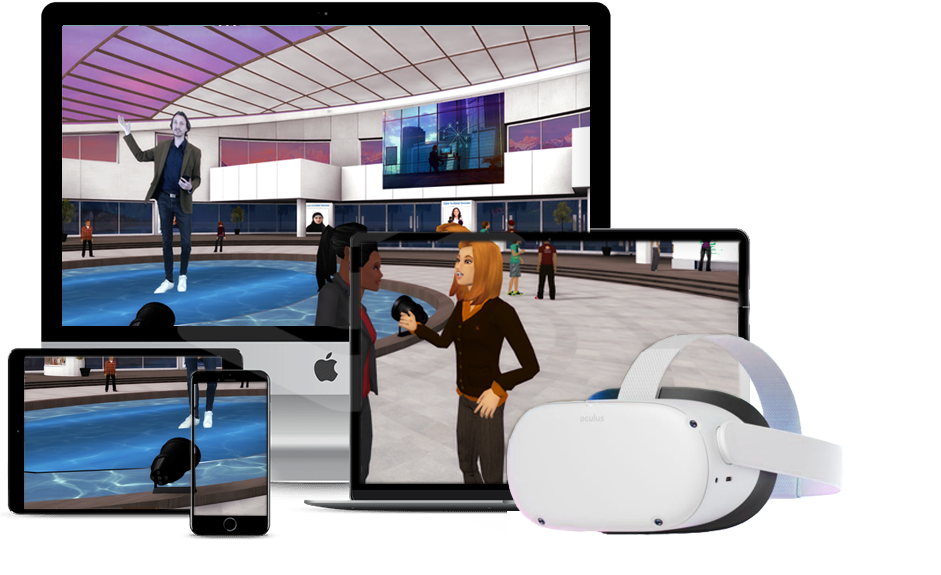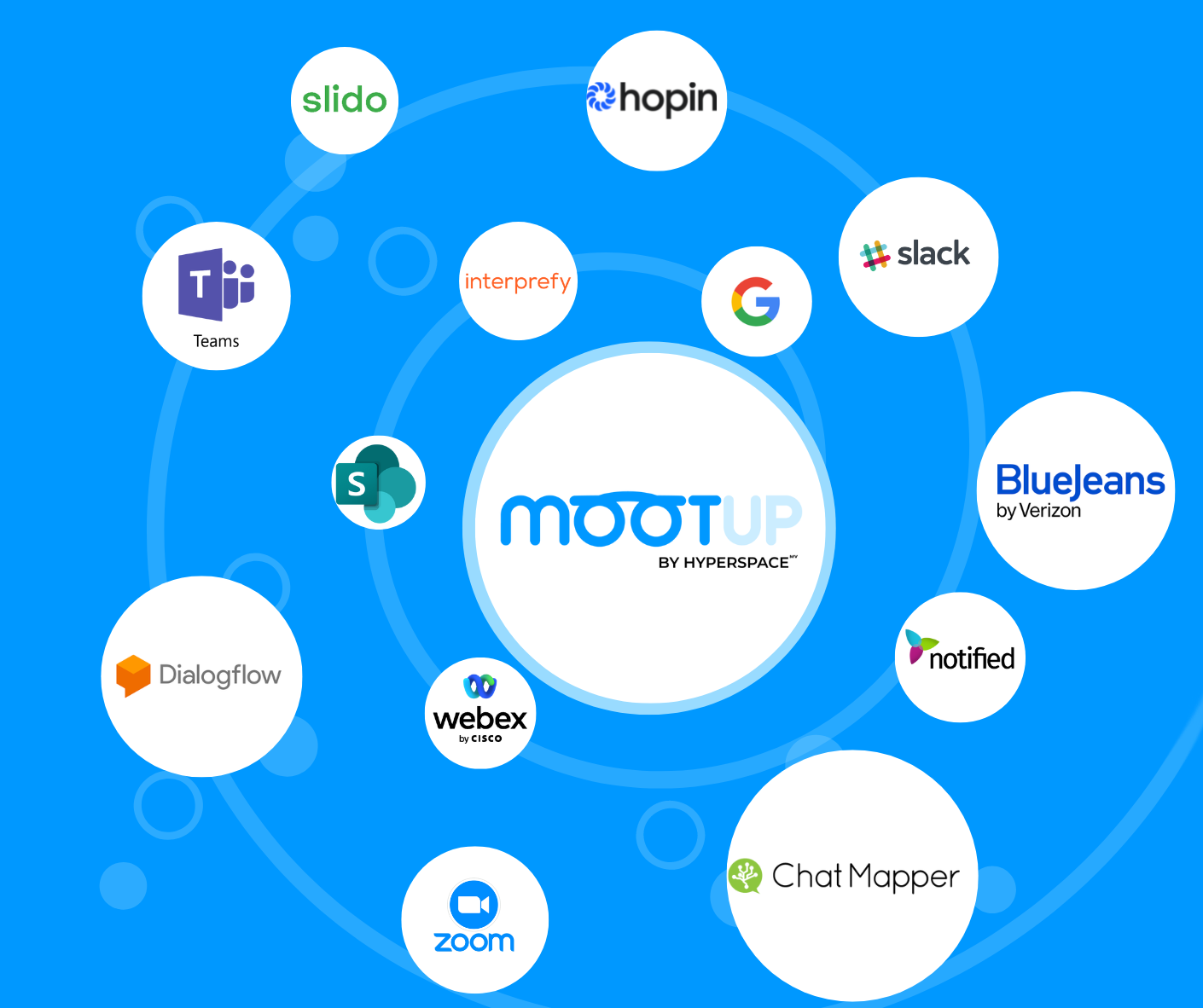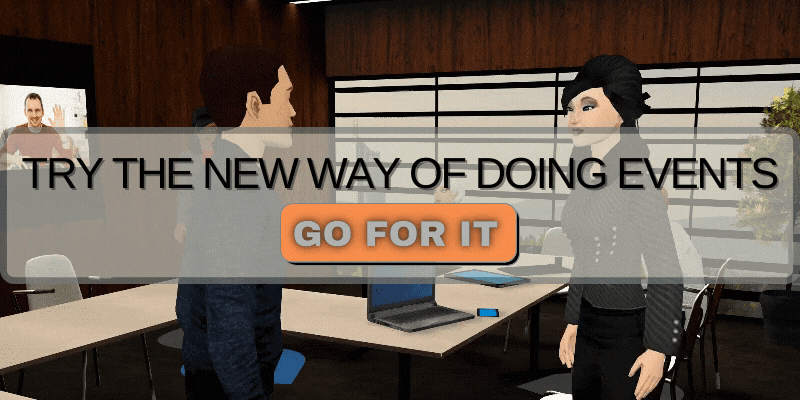As the business world evolves, virtual reality meeting platforms become increasingly popular among event industry professionals. These innovative solutions provide a more immersive and engaging experience than traditional video calls, offering new opportunities for collaboration and communication in remote work environments.
In this blog post, we will explore the different types of virtual reality meeting platforms available today and discuss their benefits. We’ll also explore how to choose the right platform for your needs by considering various factors such as features, cost, and integration options with other technologies.
Furthermore, we will guide you on setting up and hosting events using these platforms while addressing security and privacy concerns. By the end of this article, you will have gained valuable insights into leveraging virtual reality meetings to enhance your professional endeavors.
Table of Contents:
- What is a Virtual Reality Meeting Platform?
- Definition of a Virtual Reality Meeting Platform
- Benefits of Using a VR Meeting Platform
- Types of VR Meeting Platforms Available
- How to Choose the Right VR Meeting Platform for Your Needs
- Setting Up and Hosting Events on a Virtual Reality Meeting Platform
- Integrating Other Technologies with Your Virtual Reality Meeting Platform
- Security and Privacy Considerations When Using a Virtual Reality Meeting Platform
- Frequently Asked Questions Virtual Reality Meeting Platforms
- Conclusion
What is a Virtual Reality Meeting Platform?
A virtual reality meeting platform allows event industry professionals to host immersive, interactive events and conferences in a digital environment. By leveraging the power of VR technology, these platforms enable attendees to experience events engagingly and realistically. This section will discuss the definition, advantages, and various forms of virtual reality meeting platforms.
Definition of a Virtual Reality Meeting Platform
A virtual reality meeting platform, also known as a VR conference platform or VR meeting space, is an online tool that uses virtual reality technology to create 3D environments where users can interact with each other through avatars. These platforms offer various features, such as spatial audio for realistic conversations, live streaming capabilities for presentations and keynotes, and customizable environments that cater to different industries’ needs. Examples include MootUp’s no-code platform for producing and hosting hybrid events in the Metaverse.
Benefits of Using a VR Meeting Platform
- Better engagement: Attendees are more likely to be engaged during an event when they feel immersed in their surroundings rather than passively watching on-screen content.
- Inclusivity: A virtual reality conference platform enables people worldwide to attend your event without any geographical barriers or travel expenses involved.
- Eco-friendly option: Hosting your event on one of these vr meeting platforms reduces carbon emissions by eliminating travel requirements while providing participants with an engaging experience.
- Data-driven insights: Many vr conference platforms provide analytics tools that help organizers better understand attendee behavior – including which sessions were most popular or how long people spent in different event areas.
Types of VR Meeting Platforms Available
Several types of virtual reality meeting platforms are available, each catering to specific needs and preferences. Some common categories include:
- All-in-one platforms: These solutions offer a comprehensive suite of tools for hosting events, including registration management, live streaming capabilities, networking features, and more. Examples include VR Conferences.
- No-code platforms: As mentioned earlier, MootUp is an example of a no-code platform that allows users to create custom environments without any coding knowledge required.
- Social VR platforms focus on creating immersive social experiences where attendees can interact with one another through avatars. Popular examples include VRChat.
- Educational VR platforms: Designed specifically for educational purposes or training sessions, these vr meeting spaces often feature interactive whiteboards and other teaching tools. An example would be Rumii.
In conclusion,
Selecting the right virtual reality conference platform depends on your specific requirements and goals as an event organizer. Understanding the benefits of such technology will help you make informed decisions when choosing between various options available in this rapidly evolving market segment.
A virtual reality meeting platform is a powerful tool to help industry professionals create and host engaging, immersive events in the Metaverse. When selecting a VR meeting platform for your upcoming event, it’s essential to ponder the requirements you have carefully.
Key Takeaway:
A no-code platform is being developed to create and host virtual and hybrid events in the Metaverse. The endeavor centers on employing VR meeting tools, enabling users to communicate with each other in a simulated setting that mirrors physical connections.
2. How to Choose the Right VR Meeting Platform for Your Needs
The right virtual reality meeting platform ensures a successful and engaging event experience. To help you make an informed decision, consider the following factors:
Considerations When Choosing a VR Meeting Platform
- User Experience: The platform’s ease of use and intuitiveness is essential to evaluate. Make sure your attendees can navigate through the virtual environment without any difficulties.
- Customization Options: Look for platforms that offer extensive customization options, allowing you to create unique and immersive experiences tailored to your brand or event theme.
- Suitable Device Compatibility: Ensure your chosen platform supports various devices such as smartphones, tablets, desktops, and VR headsets like Oculus Rift or HTC Vive.
- Tech Support & Customer Service: Opt for providers with responsive customer support teams who can assist in troubleshooting technical issues during setup or throughout your event.
Features to Look for in a VR Meeting Platform
To maximize engagement at your events, seek out these key features when evaluating vr conference platforms:
- Multimedia Content Integration: A good platform should allow seamless integration of multimedia content such as videos, presentations, images etc., enabling richer attendee experiences.Social Interaction Tools: Incorporating tools like chat functions and live Q&A sessions will encourage networking opportunities among participants within the virtual space. Data Analytics & Reporting: The ability to track user behavior data (e.g., session attendance and content downloads) can provide valuable insights to improve future events and measure ROI. Scalability: Select a platform that can accommodate varying event sizes, from small meetings to large conferences with thousands of attendees.
Cost and Pricing Models for Different VR Meeting Platforms
Different virtual reality meeting platforms offer various pricing models. Some common options include:
- Pay-as-you-go: This model allows you to pay only for the features and capacity you need on an as-needed basis.
- Subscription-based: A subscription plan typically includes access to a range of features at a fixed monthly or annual cost.
- Tiered Pricing: Providers may offer different tiers based on the number of users, features included, or level of customization available.
Examine multiple suppliers’ services to identify the most suitable one for your spending plan and needs. For example, consider exploring MootUp’s flexible pricing plans designed specifically for hosting immersive virtual experiences in their no-code platform (see their pricing page here). By carefully weighing these factors when selecting your vr meeting platform provider, you’ll be well-equipped to create engaging events tailored perfectly to suit your audience’s needs and organizational goals.

Selecting the optimal VR conferencing platform for your needs may be challenging, yet with proper research and thoughtfulness, you can find one that meets all your event’s requirements. With this knowledge in hand, you are now ready to move on to setting up and hosting events on a virtual reality meeting platform.
Key Takeaway:
A no-code platform is being developed to create and host virtual and hybrid events in the Metaverse. This project focuses on virtual reality meeting platforms that can provide an immersive experience for attendees.
3. Setting Up and Hosting Events on a Virtual Reality Meeting Platform
Organizing a gathering utilizing a virtual reality conferencing stage can be an energizing experience for both the host and members. This section will guide you through the steps to set up your event, share tips for hosting, and provide best practices for engaging participants during your VR meeting.
Steps to Set Up an Event on a VR Meeting Platform
- Selecting the right platform: Based on your requirements, choose from various vr meeting platforms available in the market, such as MootUp, specifically designed for organizing virtual and hybrid events in the Metaverse.
- Create an account: Sign up with your chosen virtual reality meeting platform by providing necessary details like email address, organization name, etc., and set up a password.
- Create your event: Once logged in, navigate to create new event option, where you’ll need to input relevant information about your upcoming gathering, including title, date & time, description etc.
- Select or design venue: Choose from pre-built venues provided by the platform or customize one according to the specific needs of your audience & theme of discussion. Li> Invite attendees: strong > Send out invitations via email, social media, or other communication methods. Ensure they have access instructions and any required software downloads before joining. Li> ol > Tips for Hosting Events on a Virtual Reality Meeting Platform h3 > To ensure smooth execution of events hosted using vr conference platforms, follow these helpful tips : p > Test your equipment and internet connection beforehand to avoid any technical glitches during the event. Li> Provide clear instructions on navigating within the virtual environment, including controls for movement and interaction with objects or other attendees; li> Assign moderators who can assist in managing attendee interactions & addressing queries throughout the session. li >
- Record sessions for future reference, especially if multiple parallel events happen simultaneously.
- Best Practices for Engaging Attendees During an Event on a VR Meeting Platform Maintaining audience engagement is crucial when hosting events using virtual reality meeting platforms. Here are some best practices that can help you achieve this:
- Interactive content: Incorporate interactive elements like polls, quizzes, or Q&A sessions to keep participants engaged and encourage active participation.
- Bite-sized presentations: Break down lengthy presentations into smaller segments followed by discussion breaks or activities that allow attendees time to digest information shared so far.
- Social networking opportunities: Encourage informal conversations among participants through chat rooms, breakout spaces or social lounges where they can network before and after scheduled sessions.
- Diversify speaker lineup: Include speakers from various backgrounds and expertise levels, as it helps maintain the interest of diverse audience groups attending your event.-li
Following this piece’s directions, you should be able to organize and host effective virtual reality gatherings easily. Now that we have discussed how to set up and host events on a VR meeting platform let’s explore integrating other technologies with your virtual reality meeting platform for an even more engaging experience.
Key Takeaway:
A no-code platform is being developed to create and host virtual and hybrid events in the Metaverse. This endeavor focuses on creating virtual reality spaces for people to interact without requiring coding proficiency or background.
4. Integrating Other Technologies with Your Virtual Reality Meeting Platform
In the current swift environment, combining various technologies without interruption is necessary for any event to be successful. This holds for virtual reality meeting platforms as well. This section will discuss various technology integration options available with VR business meetings, VR conference platforms and their benefits.
Overview of Technology Integration Options with Your VR Meeting Platform
Integrating virtual reality meeting platforms and applications can significantly enhance the functionality and user experience offered by a virtual reality conference platform. Some common integrations include:
- Video conferencing tools (e.g., Zoom, Microsoft Teams)
- Social media platforms (e.g., Facebook, Twitter)
- Customer relationship management (CRM) systems (e.g., Salesforce)
- Email marketing software (e.g., Mailchimp)
- Project management tools (e.g., Trello, Asana, Mozilla hubs)
Benefits of Integrating Other Technologies with Your Virtual Reality Meeting Platform
Beyond enhancing your virtual event’s capabilities and virtual reality meeting, the app integrating other technologies into your vr meeting platform offers several advantages:
- Improved Efficiency: Integrations streamline workflows by allowing you to manage multiple aspects of an event from one central location. Enhanced Communication: Connecting social media or messaging apps enables real-time communication among attendees during events. Increased Engagement: Incorporating interactive tools like polls, quizzes, or gamification elements can boost attendee participation and enjoyment. Better Data Collection: Integrating CRM systems allow you to collect valuable data on attendees for future marketing efforts.
Unleash the full potential of your Metaverse with MootUp‘s 100+ integrations, seamlessly connecting with popular tools such as Zoom, Hopin, Cornerstone OnDemand, Articulate, Slack, and more, amplifying your virtual experiences with the tools you already know and love.
Examples of Popular Technologies That Can Be Integrated with Your VR Meeting Platform
Many virtual reality meeting platforms and virtual reality meeting apps offer built-in integrations or APIs that allow you to connect various technologies. Some popular examples include:
- Zoom: A widely-used video conferencing tool that can be integrated into your vr conference platform for live presentations and discussions.
- Salesforce: This powerful CRM system can help track attendee information and engagement during events, enabling better follow-up strategies.
- Slack: Integrating this popular messaging app facilitates real-time communication among event participants.
- Mailchimp: Connecting this email marketing software enables the efficient management of invitations, reminders, and post-event communications.

Integrating other technologies with your virtual reality meeting platform can help you create a more immersive and interactive experience for attendees while ensuring that the event is secure. Before initiating a virtual reality gathering, it is essential to consider the security and confidentiality issues associated with its utilization of Horizon workrooms.
Key Takeaway:
A no-code platform is being developed to create and host virtual and hybrid events in the Metaverse. This endeavor aims to create virtual reality conferencing solutions that let people participate in events from any area without moving.
5. Security and Privacy Considerations When Using a Virtual Reality Meeting Platform
As virtual reality meeting platforms gain popularity, it is essential to understand the security and privacy implications of using these tools for your events. This section will provide an overview of the measures taken by different VR meeting providers, discuss data collection policies, and offer tips for ensuring security and privacy when using a virtual reality meetings provider.
Overview of Security and Privacy Measures Taken by Different VR Meeting Providers
Different VR meeting platforms or business meetings employ various security measures with their immersive technologies to protect user data and ensure secure communication during video calls and events. Some common practices include:
- Encrypting data transmitted between users is a common practice to ensure secure communication during events.
- Password protection: Requiring passwords or unique access codes for joining events can help prevent unauthorized access during remote work.
- Moderation tools: Hosts should have control over attendee permissions, such as muting participants or removing disruptive attendees from the event.
- Regular updates: Keeping software up-to-date helps address potential vulnerabilities in the platform’s codebase.
Understanding the Data Collection Policies of Different VR Meetings Providers
Before selecting a virtual reality conference platform, reviewing their data collection policies is crucial. Policies detailing the types of personal data collected from users, how it’s employed, kept and shared with third parties (if applicable), and any available opt-out options should be considered before settling on a virtual reality conference platform. To maintain transparency with attendees about their privacy rights while attending your event on a VR conference platform like MootUp or others, consider sharing links to relevant policy documents within pre-event communications.
Tips for Ensuring Security and Privacy When Using a Virtual Reality Meetings Provider
Here are some tips to help you maintain security and privacy while hosting events on VR meeting platforms:
- Choose a reputable provider: Opt for well-established virtual reality meeting platforms with proven track records in maintaining user privacy and data security.
- Create strong passwords: Use unique, complex passwords for your event access codes and any administrative accounts associated with the platform.
- Educate attendees about best practices: Share guidelines with participants regarding password protection, software updates, and other relevant measures they can take to protect their information during the event.
- Maintain control over content sharing: Restrict screen-sharing or file-sharing capabilities within the platform to trusted presenters only. This helps prevent unauthorized users from sharing potentially harmful content during your event.
Incorporating these strategies will enhance the overall experience of your virtual reality conference and instill confidence in attendees that their personal information is being handled responsibly by both you and the chosen VR meeting platform.
Key Takeaway:
A new project aims to create a no-code platform for hosting virtual and hybrid events in the Metaverse. The goal is to make it simple for users to produce engaging virtual reality encounters without technical knowledge.
Frequently Asked Questions Virtual Reality Meeting Platforms
Can VR be used for meetings?
Yes, virtual reality (VR) can be effectively used for meetings. VR meeting platforms enable participants to interact in immersive 3D environments, facilitating collaboration and engagement. These platforms offer features like spatial audio, avatars, and interactive tools that enhance the overall meeting experience. Some popular VR meeting platforms include MootUp, VRChat, and Spatial.
What is a virtual meeting platform?
A virtual meeting platform is an online tool or service that enables users to conduct remote meetings using video conferencing technology. It allows participants to communicate in real time through audio, video, chat messages, and screen sharing. Popular virtual meeting platforms include Zoom, Microsoft Teams, and Google Meetа>.
What are the benefits of VR meetings?
The benefits of VR meetings include increased engagement due to immersive experiences; enhanced collaboration with interactive tools; elimination of geographical barriers; reduced travel costs; improved focus by minimizing distractions from physical surroundings; opportunities for creative presentations with 360-degree visuals and animations; ability to simulate real-world scenarios for training purposes.
What are the 3 types of virtual reality?
The three main types of virtual reality are non-immersive, semi-immersive, and fully immersive. Non-immersive VR involves limited interaction with a 3D environment using devices like desktop computers or tablets. Semi-immersive VR provides more engagement through large screens or projection systems while still maintaining some connection to the real world. Fully immersive VR offers a complete sensory experience by utilizing headsets, motion tracking sensors, and haptic feedback devices, even on mobile devices.
Conclusion
Overall, virtual reality meeting platforms are a powerful tool for hosting events and meetings in the Metaverse. From choosing the right platform to setting up your event securely, there is much to consider when selecting and using these solutions. Taking the necessary steps and focusing on details makes it possible to ensure that your virtual or mixed-mode event progresses without any issues while giving participants an unforgettable experience.
MootUp‘s browser-based platform empowers you to “futureproof” your MetaMetaverseanting seamless access across smartphones, mobile devices, tablets, laptops, and VR/AR headsets without downloading or installing software, ensuring unparalleled convenience for all users.
Take your meetings to the next level with MootUp, a no-code platform for creating and hosting virtual or hybrid events in the metaMetaverseth its powerful features and intuitive design; you can host professional meetings that make an impact.

